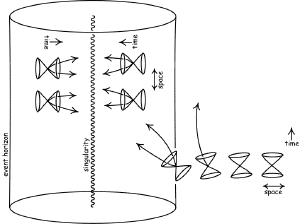Post
Sphere of Influence
21 October 2013
Suppose you were to flash a light where you are at this moment. The light would speed away from you at about 300,000 kilometers per second, which is known as the speed of light. In general you could point the light in any direction, so flash of light would in general be an expanding sphere of light.
Since nothing can travel faster than the speed of light, then that expanding sphere marks the limit of your influence. After one second it is about 300,000 kilometers in radius, for example, and that means in one second you cannot do anything beyond that range. You can’t get a radio signal to someone more than 300,000 kilometers away from you in a second. In general, you can’t move outside that sphere in one second, because you can’t travel faster than light.
It can be difficult to visualize this sphere of influence for a point in space, so often it is visualized by imagining space as a two-dimensional surface, like a sheet of paper, and time as being the third dimension. You can imagine it as a stack of paper, with a cartoon drawing on each page, then flipping through the drawings would make them appear to move. Each sheet of paper would be a moment in time, and different pages in the stack of paper would be different moments in time. The only difference is that time is a continuum rather than discrete instants.
In this visualization, an expanding sphere of light would start at a point, and with each higher page would be a larger and larger circle. If you flipped through the pages you would see an expanding circle of light. If instead you could see through the paper and just look at the circles, then you would see they form a cone starting at a particular point. This is known as a light cone, and it defines the limit of influence of an object at the point. An object at the starting point cannot influence anything outside of that light cone, nor can it ever move beyond the limit of that light cone.
Even though our limit of influence is an expanding sphere, the cone visualization is so useful we refer to the sphere of influence of a particular point as its light cone. You can also trace the cone backward in time, which defines the limit of things that can influence our object. To be able to interact with an object you must be within its past light cone, and to be influenced by an object you must be within its future light cone.
Where things get interesting is when you introduce gravity. Since gravity is a warping of space and time, gravity distorts the light cones of an object. You can see this in the light cone visualization of black holes, as seen in the figure below. Since time is the vertical coordinate in this image, the black hole (which exists over time) looks like a vertical tube.
 John D. Norton
John D. NortonAny mass warps space around it, which cause the light cones to tilt toward it slightly. This tilting is what we observe as the warping of space and dilation of time due to gravity. For most masses this tilt isn’t significant, but it is significant close to a black hole. In fact, there is a distance at which the light cone tilts to the point that the edge of the cone is vertical. This means it is impossible for you to get further from the black hole, you can only get closer. This point is known as the event horizon. Get closer than that distance, and it is impossible to leave the black hole. Black holes are a trap because they distort space so strongly, and we can see this in the behavior of the light cones.
Light cones are a useful tool for understanding the behavior of strong gravitational regions. By visualizing the limits of our sphere of influence, they help expand our sphere of knowledge.